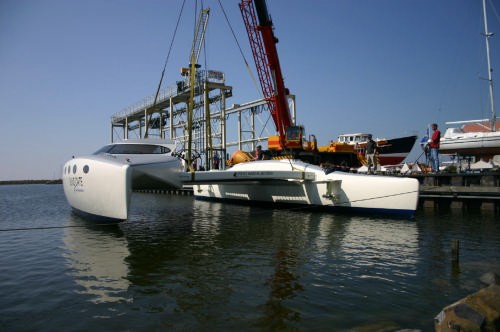The Future of Cruising Boats?
by Rob Denney on 21 Feb 2006

Blind Date Rob Denney
Blind Date, the first professionally built harryproa was recently launched in Holland. Two weeks later, Rare Bird was launched in Coffs Harbour, Australia.
Harryproas are arguably an entirely new type of cruising boat, the first since trimarans were introduced in the 60's.
What makes them unique?
1) They are the least possible boat for their accommodation and cost. Blind Date weighed 1,700 kgs/1.7 tons when launched. The rig will take this to 2 tonnes/tons. This would be exceptional for a 15m/50' high tech racing multihull. For a cedar strip planked cruising boat with 2 huge double berths, covered cockpit with seating for 8, full headroom, toilet/shower and galley, it is unheard of.
The low weight is achieved by concentrating all the sailing loads in a very small area rather than having to strengthen the entire boat to support the rig and associated loads. The low weight means less materials are required and less labour to apply them. Minimal surface area and simple shapes with most of the interior being a structural part of the boat result in further reductions in labour costs.
Blind Date has taken 3,500 hours to sailing stage. Number 2, which is set up for extended cruising 4,500.
2) Harryproas are the easiest to sail and arguably the safest multihulls.
This is achieved in a number of ways:
a) The entire rig can be completely depowered on any point of sail by releasing one lightly loaded line. This is achieved by using an unstayed carbon mast and a balanced, ballestron rig, in which the main boom extends past the mast and has the jib mounted on it (see diag 1). The balanced rig has the added cost and safety benefits of not requiring highly loaded winches, travellers, tracks or ropes. There is also no need for fore beams, strikers, stays or chainplates, nor all the beefing up required to support them.
Obviously, there is also far less to break, maintain and replace.
b) Harryproas do not tack, they shunt. Shunting is comparatively effortless.
Release the single sheet, rotate the rudders through 180 degrees, pull in the other sheet and sail off in the other direction (see diag 2). There is none of the fear associated with tacking or gybing in big winds or waves, no worrying about getting caught in irons and no highly loaded ropes and equipment looking for heads and fingers to crush.
Shunting is easily reversible at any time. It is by far the fastest way to get back to a person overboard, where the ability to stop, completely depowered, makes retrieval as easy as possible.
c) All sail controls are accessible from the walkway across the middle of the central trampoline. There is no clambering over high cabins, along narrow side decks or venturing out to a pitching bow. The mast is central and the trampoline is bounded by 300mm/12' high beams and the two hulls. For most sail adjustments, the rig can be feathered into the wind, so there is no spray and sail loads are minimised.
d) Despite their very low weight, harryproas have a high righting moment as the majority of the weight is in the accommodation hull, which is always to windward. This, coupled with the small rig possible on such a long, light boat and the inherent flex in an unstayed mast makes them very stable. The rig has the added safety feature of flexing in a gust, thus depowering the rig automatically, making reefing a rarer event.
e) Harryproas have no keels, centreboards or daggerboards. Instead they have
two oversize rudders, mounted on the inboard side of the lee hull, on brackets
which are above the waterline. Not only is this cheaper and less drag than the usual 2 boards/2 rudders set up, it is immeasurably safer. In the event of a grounding or collision, the rudders kick up. They can also be raised manually for shallow water sailing or to minimise the tripping effect in storm waves. There are no fittings or holes below the waterline, nor any chance of damaging the bottom of the boat in a grounding. The rudders allow incredible control.
Blind Date has a turning circle of one and a half boat lengths with a single, fixed, centrally mounted outboard. Both rudders can be set at an angle to enhance windward performance, or more importantly, to crab sideways off a dock.
Blind Date was designed specifically for the Dutch Blind Sailing Association, Zeilen met Visie. They needed a boat which allowed up to 6 blind people and 2 crew to feel safe, move about easily, not heel and at the same time allow them to feel the acceleration and speed.
These requirements are not very different from those of sighted cruisers! It is owned by Jan Schippers and was built by Rudolp van der Brug. It will be used for day sails, weekending and occasional longer trips and is available for charter on and around the Ijsselmeer.
Rare Bird was designed for medium term cruising for a couple and their many friends. It features a semi solid bridgedeck, (including dinghy launching ramp), 2 outboards, enclosed pilot house with nav station and dining table for 8 and a more complex layout. It weighed 2.5 tonnes when launched, sans rig. It is owned by Johnny Richards and was built by Harryproa at Coffs Harbour, where it will be based.
The freestanding carbon masts were built using a technique that requires neither expensive moulds nor autoclaves. Both boats will be sailing later this year and a report on their sailing and cruising capabilities will be forthcoming.
For more information please see http://www.harryproa.com/
or contact:
Rob Denney
email:proa@iinet.net.au
13A Devon Road Swanbourne 6010 Western Australia
If you want to link to this article then please use this URL: www.sail-world.com/21821